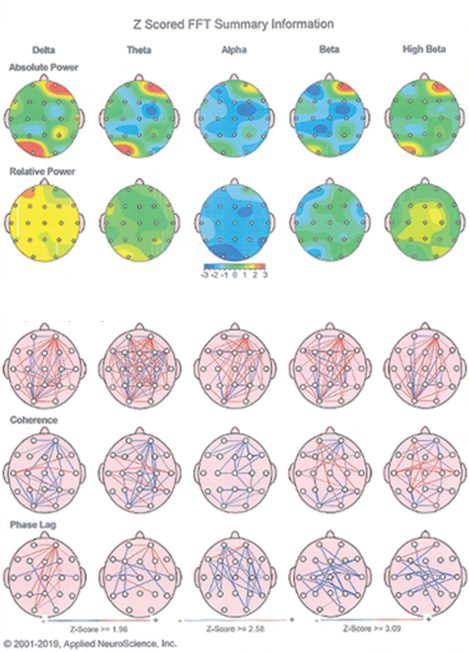By Robert W. Pollack, M.D. CEO
The APA (American Psychiatric Association) says that depression is a serious medical illness that negatively affects how you feel, the way you think, and how you act. Since many medical illnesses and medications can mimic depression, it is mandatory that depression should be diagnosed and treated by medical specialists known as psychiatrists, which are trained in these areas. To begin a quest for relief by not turning to a psychiatrist is like asking a mechanic to build a watch.
Over the past nine years, psychiatry has experienced significant growth in treatment modalities making it more efficient for patients who suffer from depression (and related illnesses) to improve and achieve remission. One of these tools is QEEG.
QEEG (Quantitative Electroencephalograms) Utilizing FastFourier Transformations (a mathematical process) we are able to look at the EEG tracings with a pictorial map similar to the heat map on the back of the USA weather page. These patterns help us identify objective features of neurological and/or psychiatric illnesses.
We can also use a mathematical process to determine Coherence. Coherence is a way to determine if 2 or more brain regions have functional connectivity. The more they are connected the more efficient the brain functionality is. This could begin to point to different brain patterns for different diagnoses. In Many Cases, Less is More.
Patient Presented with Depression
Patient X came to see us with a long history of Sjogren’s Syndrome and Depression. She was taking two antidepressants and one antianxiety medication. Her mental status exam revealed significant depression along with feelings of hopelessness and anhedonia (inability to feel pleasure). The baseline qEEG and associated coherence studies are shown in the top images to the right. Information dated December 20, 2019 is from the patient’s first visit. Information dated January 10, 2020 is from the follow up visit. 

Images from the first visit have a pervasive presence of dysfunctional brain regions that can be seen in red. The smaller images show a more marked decrease in alpha coherence which reflects the patients decrease in psychic energy and depression.
Through Dr. Pollack’s Intervention The Patient Shows Marked Improvement
The image dated January 10, 2020 shows a decrease in dysfunctional areas and greater symmetry.
The alpha coherence shows an increase in effective networking reflecting patients increase in mood and energy and the decrease in anxiety.
There are increased areas of activity clearly seen in the coherence scan’s for Patient X. The treatment used for this patient was the cessation of medication. After several weeks away from the medications she improved. Patient was alert, energetic, with minimal anxiety and no significant depression. Completed *PHQ-9 score at the initial appointment was 20. Completed PHQ-9 at the follow up visit was 0.
Conclusion was, sometimes less is more. There are many other factors that we can address, however it is worthy of note that less may be more.
*Patient Health Questionnaire (PHQ-9) is a self-endorsed depression assessment. These scores will measure mood, for example a score of 0 would indicate absence of depression. A score of 27 indicates severe depression. This questionnaire can be administered as often as every two weeks.
PASWFL
6804 Porto Fino Cir #1, Fort Myers, FL 33912
Office: 239-332-4700
https://facebook.com/PASWFL/
https://www.linkedin.com/in/paswfl/
 Southwest Florida's Health and Wellness Magazine Health and Wellness Articles
Southwest Florida's Health and Wellness Magazine Health and Wellness Articles

